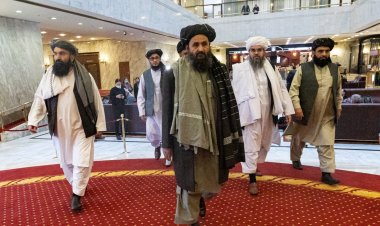The Red Terror: A look at Naxalism in India
Naxalism or Maoist insurgency in India threatens the integrity and social fabric of the country. The ideological underpinning of the movement is based on the political experience of the previous century and hence becomes outdated for the modern globalized world.

Overview
By Akshay Kumar
Evolution of Naxalism in India
Over the past five decades, Naxalism or Maoist insurgency in India has not only survived but also expanded to become one of the major internal security threats to the country. The war which started in the rural hinterlands of eastern and central India has affected approximately 40 percent of Indian territory and 35 percent of its population in the past decades.
According to some historians, the Maoist uprising in India started as part of the Telangana movement itself in the 1940s. Led by the armed cadres of the Communist Party Of India (CPI), around 2500 tribal villages in Andhra Pradesh formed themselves into small and independent communes as part of the peasant revolution in 1948. However, the modern-day Naxal movement claims to have its root in the violent peasant uprising of the Naxalbari village in West Bengal in March 1967. Inspired by the communist revolution in China, a faction of CPI leaders led by Charu Mazumdar, Kanu Sanyal and Jangal Santhal broke away from the party to follow a more radical line of armed revolution to gain state control.
Supported by the peasant classes struggling against the repressive revenue system by the landowners, the insurgency soon spilled to other states including Bihar, Uttar Pradesh, Orissa, Madhya Pradesh, Kerala and Andhra Pradesh. The rebellion also garnered a lot of support from the urban educated elites and students, some of which also travelled to the tribal forests to join the armed rebellion. However, the movement soon lost its momentum and failed to create a revolutionary chain reaction in the absence of a strong organizational base. Alongside, political schisms and widespread factionalization within the movement couldn’t sustain the counter-insurgency measures by the state.
The Naxal insurgency again resurrected in the late 1980s with the formation of the Peoples Wars Group (PWG) in Andhra Pradesh under K. Seetharamaiah. Unlike before, this new group focused on the consolidation of the organization and mobilization of support from the rural lower class. The armed cadres of PWG operated in hilly and forested areas of Telangana and adjacent areas of Bastar and incrementally forced out state officials and machinery. During the same period, another group, the Maoist Communist Centre (MCC), also operated in Bihar and West Bengal.
The Maoist movement since then has spread to many parts of India, especially in the remote tribal belt of the country, infamously known as the “Red Corridor”. In a significant development in 2004, PWG, MCC and several other Maoist splinter groups joined together to form the Communist Party of India (Maoist). Since then, CPI (Maoist) is the single biggest ultra-left-wing group in the country and is responsible for the majority of violence related to left-wing extremism in India.

Source: South Asian Terrorism Portal (SATP)
Maoist ideology and strategy
Maoism is a Marxist-Leninist ideological doctrine and mechanism of revolution composed by the leader of communist China, Mao Tse Tung. It is based in the capture of state power through the means of an armed insurgency (guerrilla warfare), political mobilization and strategic alliances. Adhering to this ideological foundation, the Naxals in India aims to overthrow the self-perspective feudal, imperial and capitalist Indian state and install a communist structure of governance in the country.
The main Maoist strategy is to entrench the gap between the exploited or marginalized classes of the society and the Indian state. They mobilize mass support from the socially and politically isolated communities and persistently take up issues like displacement of Adivasis, human rights violations by state institutions and industrial exploitation. Whereas, the military strategy aims to create a revolutionary base area of operations in the remote and isolated territories where state apparatus has a limited or negligible presence, and wage a protracted war against the Indian state. This also allows them to recruit armed cadres from the same demography.
Alongside, CPI (Maoist) also employ considerable resources in maintaining the public and media discourse sympathized to their cause. Several overground Naxal organizations and imminent personalities use state institutions, popular medium and legal recourses to bolster the Maoist agenda and urban movement. Interestingly, Maoists are using the same democratic structure and institutions which they discredit and fight against. Naxals also attempt to galvanize support from urban youths and students from many national and regional universities. Ironically, the ideological fuel to the insurgency is provided more from the outside as certain sections of the elitist intellectual class see it as a convenient means to legitimize their ideological beliefs.
However, the primary means of control by Naxals is fear and violence. The poor and tribal classes are subjected to high coercive means of administration and any dissent is dealt with extreme punitive measures through Kangaroo courts (Jan Adalats) and public display of brutal executions. People are often labelled as police informants or state sympathizers and subsequently killed to satisfy personal vendettas and disputes. Naxals also restricts any form of state-led services reaching the masses including roads, electricity, healthcare, schools etc. The aim is to isolate the people and restrict their exposure to mainstream society. Alongside, things such as forced recruitments and celibacy, extortion, hermit administration etc, signify the non-receptiveness of the masses towards the Maoist cause and punctures the claims of it being a people-led movement.
Material capacities
For the military campaigns, Naxals are dependent on limited arms and ammunition, and other rudimentary fighting tools such as bows and arrows. For a long time, the modus operandi for arms procurement was through local sources and looting from the police stations and security forces. However, gradually the Maoists developed a sophisticated system of local manufacturing of arms, mortars and improvised explosive devices. Several intelligence reports also pointed towards the arms procurement, training of the armed cadres, and funding from other insurgent groups in South Asia. Therefore, today the military capacity and fighting capabilities of the Maoist groups have been increased significantly and they have their own procurement and R&D wing.
Naxals have also managed to create a sophisticated network of a shadow war economy, with estimated annual funding of 1.25 billion USD. One of the biggest sources of funds is extortion from the local people and businesses. They are also involved in organized crime activities like drug trafficking, kidnappings and killings. Additionally, another major source, and probably the most controversial one, is the extortion of money from the industrial companies and even MNCs operating in the tribal areas. The involvement of the Maoist group in these extorting and coercive methods to gain finances has been widely criticized and the normative foundations of the movement have been questioned for the same. Meanwhile, the Naxals justify these actions on the pretext of the liberation of people and the greater good of their cause.
Response from Indian states
Acknowledging the situation as more socio-economic at the core along with its military and armed characteristics. The government of India has adopted a holistic approach to tackle left-wing extremism which involves maintaining security, connectivity, development, ensuring rights, improved governance and management of public perception. The integrated approach has substantially reduced the geographical area of operation of the Maoist groups and shrunk the most violent activities to certain remote districts. According to the government of India, currently, there are 41 districts of India that are affected by left-wing extremism compared to 96 in 2010.
However, the current approach is also not devoid of its inherent contradictions and challenges. The highly politicized centre-state relations often create operational and organizational challenges. This is also evident from the desynchronized efforts and misunderstanding between the Central and state armed forces. Also, the state police often lack training and leadership problems as only lower cadre officers are sent for counter-insurgency operations. Along with this, widespread corruption, political roadblocks and lethargic administrative response are making the counter-insurgency measures counterproductive.
Conclusion
Naxalism or Maoist insurgency in India threatens the integrity and social fabric of the country. The ideological underpinning of the movement is based on the political experience of the previous century and hence becomes outdated for the modern globalized world. Although, the military movement is marginalized to the remote pocket of the country, but the rising popularity of Maoist cause amongst the urban intellectual class and modernization of insurgency tools and techniques still makes it a severe threat to Indian internal security. Therefore, the state cannot lower its guard and should close the loopholes in its response by addressing the grassroot problems underlying this issue.
Disclaimer: This paper is the author’s individual scholastic contribution and does not necessarily reflect the organisation’s viewpoint.


























